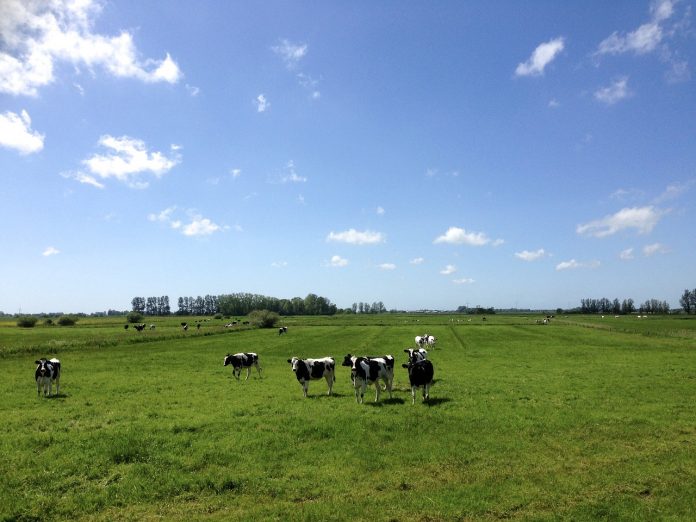Spring is here, according to the calendar, but cold temperatures and many water-saturated soils have not made rotational grazing very favorable yet. However, soon warmer temperatures will promote grass growth so that pasture rotations may start.
As the number of daylight hours increase, temperatures warm, and pastures grow, farm managers should take steps to prevent hypomagnesemia or “grass tetany.”
Grass tetany is associated with cool weather in spring and fall because the metabolism of the plant is slower and its mineral uptake from the soil is reduced. This leads to lower amounts of magnesium (Mg) in the forages livestock graze.
Grass tetany is more common on cool-season grass pastures than legume pastures because legumes such as clover and alfalfa tend to have higher magnesium levels in their leaves.
Green pastures
Turning cows out into new lush, grass pastures can cause lower blood levels of magnesium and cause an imbalance. This dangerous and unwanted condition is likely increased in pastures if nitrogen or manure is applied in the spring.
In addition, if soils contain high levels of potassium or the pH of the soil is low, increased risks of grass tetany exist. Therefore, do not apply nitrogen or potassium (potash) to pasture areas in early spring.
A relationship between soil phosphorus content and Mg uptake in forages occurs too. If phosphorus levels in the soil are too low, even if soil Mg is adequate or high, the plants may not take up the Mg in normal amounts to meet the livestock’s needs.
Standard soil tests provide this type information so you can monitor your situation.
Symptoms
Early symptoms of grass tetany are things like muscular weakness, animals suddenly stop grazing, they appear uncomfortable, start staring, hold their heads up and have their ears in the erect position.
This may be followed by incoordination, or a staggered gait that progresses until animals lie down and can no longer get up.
Treatment must be administered in the early stages of grass tetany if it should occur.
Cattle that are down longer than 6-8 hours have a lower chance of survival, so close monitoring this time of year is advised.
Cattle most likely affected by grass tetany are the older cows and high milk-producing animals after they have calved.
Soil testing
If soil tests show your pH is low (< 6.0) and Mg is low, adding high-mag limestone (dolomitic limestone 12-15 percent Mg) will increase the pH while adding Mg to the soil. If your soil analysis shows less than 100 pounds Mg per acre, you have a high potential for grass tetany.
Adequate Mg in the soil would be more like ±250 pounds/acre. Spreading one ton of dolomitic lime/A provides about 240-300 lbs. of Mg/A to the soil. If your soil pH is adequate, but Mg is low, consider adding magnesium oxide to the soil to bring levels up to minimum requirements.
Adding these nutrients to soil will change the amounts the plants take-up, but it will take time and is not a quick solution for Mg deficiencies.
Grass tetany can generally be avoided by feeding minerals with high Mg content or supplemental Mg and adequate amounts of salt.
Commercial mineral mixes that are effective in preventing grass tetany are available, commonly called high-mag mixes; these minerals contain 12 to 14 percent Mg. Loose salt/mineral mixtures should be provided every few days so livestock can consume appropriate amounts each day.
If livestock must lick blocks, or loose mixtures that have hardened, they typically cannot consume adequate amounts of minerals needed each day.
Incorporated nutrients
Magnesium oxide is an inexpensive source of Mg if you want to formulate your own mix. However, animals do not readily accept mag-ox so it needs to be incorporated with something such as dried molasses, other minerals, concentrated feeds or salt supplements. Magnesium oxide is about 60 percent magnesium, so lactating cows should consume approximately 1-1.5 ounces of mag-ox per day to maintain acceptable levels of Mg in their diet at this time of year.
Intake of supplemental Mg should be monitored regularly to be sure lactating animals are consuming proper amounts during the high-risk periods.
Summary
Farm managers should monitor livestock frequently in the spring and provide sufficient loose high-mag minerals every few days.
Managers should encourage legume forages to grow along with the grasses in pastures to help reduce the potential of grass tetany.
Plants that are more than 8-10 inches tall (more mature) are less likely to cause grass tetany than new, lush, and fast-growing short grass shoots that are common in continuously grazed pastures.











